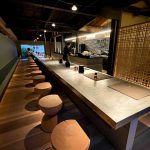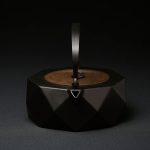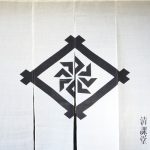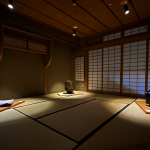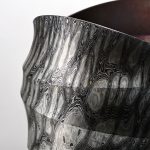伝統的金属工芸品は、作品タイトルに叙情的な名前をつけることが少なく、代ってその用いられる材質、技法、用途などを直接的に名づけることが多いようです。たとえば「日本伝統工芸」展を見渡しても、陶磁器につけられる名前と少し趣が違います。

鍛銀鎚目香炉綸子文透(たんぎんつちめこうろりんずもんずかし)
この作品も、「打ち延べて作る鍛造」技法、「純銀」をもちいて製作された香炉で、火舎(火屋:ほや)の部分の透かし彫りが「綸子(りんず)」文様になっています。
“Tangin Tsuchime Kouro Rinzuzukashi”
(Forged Silver with Hammered Texture Censer and Open Silk Weaving Pattern)
It is rare to put an expressive title on traditional metal craftwork; instead it is more common to name things directly based on material, technique or usage. For example, even if you look around the ”Japanese Traditional Craft” Exhibition, the appearance is slightly different from the names given to pottery.
This piece is an incense burner made in “fine silver” using the “raising” technique, and the open carving on the top has a “Rinzu”(silk weaving) pattern.

火舎:ほや(火屋、穂屋とも書きます)は、「香炉の顔」とも言われます。香炉の価格のほとんどを、火舎が占めることが多いほどです。
この入り組んだ幾何学的な文様(もんよう)は、日本の伝統的なもののひとつ。碗状に成形してから、糸鋸(いとのこぎり)を用いて1穴づつ切り出します。精密に切り抜くことも難易度が高く地道な作業ですが、曲面を考慮した上で直線的な文様をうまく配列する下書きの作業が困難を極めます。
The “Hoya”(top of the incense burner) is also called the “face of the censer.” It often happens that the Hoya constitutes most of the cost of the incense burner.
This complex geometric pattern is one of the traditional patterns of Japan. After it is formed into a bowl-like shape. The openings are cut out one by one using a traditional jigsaw. The process of cutting the spaces out accurately is relatively difficult and requires persistence, and to making the underdrawing of the strait line pattern while considering the curved surface also adds another level of difficulty.

火舎と本体とは分かれ、「落とし」部分に灰を入れ炭団(たどん:炭の一種)を焚き香木を加熱する仕組みになっています。「落とし」は胴体とも一体化しておらず、中で焚いた炭団の熱を胴体に伝えないようになっています。いずれも純銀の板を金鎚で延べ絞り、成形します。
The Hoya and the main body is separate, and it is set up so that the “Tadon” (type of aromatic wood) is heated by burning charcoal inside the “Otoshi”(an inner container). The Otoshi is also separate from the main body so that the heat does transfer. Both parts are made from a sheet of silver using the technique of raising.
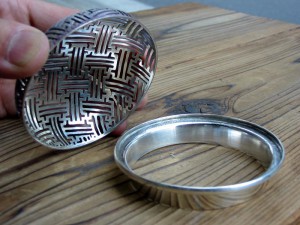
火舎の透かし部分は通常、脚になる部分としっかり固定されていますが、煙によるヤニの掃除を考慮して分解も可能な仕組みになっています。また、ヤニを除去しやすいよう、火舎の裏側はつるつるに研ぎ磨かれています。
The Hoya is usually firmly attached to the part which acts as the stand, but considering the need to clean the tar from the smoke, this one is made so that it can be taken apart. Also, the inner surface of the Hoya is highly polished and smooth to make it easier to remove the tar.
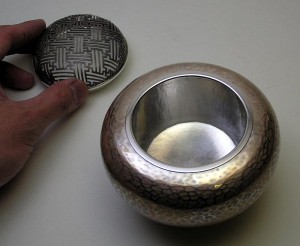
時代を経た銀だけがもつ「いぶし」、すなわち古美色を、これは人工的に着色しています。本来なら何十年をかけて纏(まと)うこの「いぶし」、人工的なものにはいくつかあり、硫黄を駆使して着色する黒味がかったもの、銅を駆使して着色する赤みがかったものがあります。この香炉には、この2種を部分的に用い、いぶしの色合いを楽しめるようにデザインしました。
Tarnished silver has the color of antique beauty and shows the passing of time. Though in reality it takes many years for silver to change to this color, we can artificially add the oxidized color.
There are a few colors, such as a blackish color which comes from using sulfur, or a reddish tone which comes from using copper. For this incense burner, we used both of these types and designed this piece so that the different shades of oxidation could be appreciated.
お買い求めについて
京都寺町二条の店舗の他、オンラインストアからもご購入いただけます。
・鍛銀鎚目香炉 綸子文透 ※SOLD OUT 当該投稿で紹介している製品は完売いたしました。
・鍛銀大香炉 綸子文透
清課堂オンラインストアでは、この他各種新作も取扱いしております。





